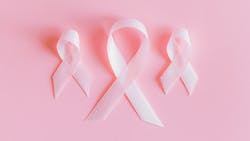Breast cancer trends account for 30% of all cancers diagnosed in women
Breast cancer is commonly diagnosed among women, accounting for approximately 30% of all cancer cases reported among women. The findings are from a Centers for Disease Control and Prevention (CDC) trend report that indicate that breast cancer incidence among women aged ≥20 years decreased during 1999–2004 but increased during 2004–2018.
During 1999–2018, breast cancer incidence among women aged ≥20 years decreased an average of 0.3% per year, decreasing 2.1% per year during 1999–2004 and increasing 0.3% per year during 2004–2018. Incidence increased among non-Hispanic Pacific Islander women and women aged 20–39 years but decreased among non-Hispanic White women and women aged 50–64 and ≥75 years.
A slight annual increase in breast cancer incidence occurred in the United States during 2013–2017. A previous study found that breast cancer incidence increased during 2004–2013 among Asian or Pacific Islander women, driven by a significant increase among those aged 45–49 years.
Another study found that among women aged <45 years born in California, breast cancer risk among Asian or Pacific Islander women exceeded that among White women.
Further examination of breast cancer incidence by detailed Asian or Pacific Islander race groups, age, cancer stage, and migration status might help further explain the increase in observed rates.
Results of this study also show that breast cancer incidence during 2010–2018 increased among women aged 20–49 years. Age and genetic, hormonal, and reproductive factors contribute to breast cancer risk. Modifiable risk factors for breast cancer include excess body weight (among postmenopausal women), physical inactivity, alcohol use, and hormone replacement therapy use.
During 2017–2018, approximately 39.7% of women aged 20–39 years in the United States had obesity (body mass index ≥30 kg/m2), compared with 20.7% during 1988–1994, and a similar increase was observed during this period among women aged 40–59 and ≥60 years.
The Community Preventive Services Task Force recommends evidence-based strategies to create social and physical environments that support healthy behaviors, such as reduced excessive alcohol use and increased physical activity. CDC’s National Comprehensive Cancer Control Program assists programs to help support and promote these strategies in communities. CDC’s Bring Your Brave campaign provides information about breast cancer to women aged <45 years.
Some forms of hormone replacement therapy taken for >5 years during menopause can raise breast cancer risk. Previous studies have associated the observed decrease in breast cancer incidence, specifically in the early 2000s, to be temporally related to the first report of the Women’s Health Initiative. The report found an increased risk of breast cancer associated with hormone replacement therapy followed by a decrease in the use of hormone replacement therapy among postmenopausal women in the United States.
In 2017, the North American Menopause Society announced that “for women aged younger than 60 years or who are within 10 years of menopause onset and have no contraindications, the benefit-risk ratio is most favorable for treatment of bothersome vasomotor symptoms and for those at elevated risk for bone loss or fracture. Women who receive hormone therapy for >5 years might need to monitor any symptoms associated with breast cancer and consult with their health care provider if any symptoms of breast cancer are noticed.
The U.S. Preventive Services Task Force recommends that women aged 50–74 years who are at average risk for breast cancer get a mammogram every 2 years. Women aged 40–49 years, particularly those who have a known first-degree relative (i.e., parent, child, or sibling) with breast cancer, should talk to their physician or other health care professionals about starting screening with mammography. CDC’s National Breast and Cervical Cancer Early Detection Program provides breast and cervical cancer screenings and diagnostic services to low-income, uninsured, and underinsured women across the United States.
